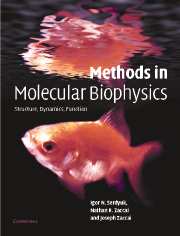Book contents
- Frontmatter
- Contents
- Foreword by D. M. Engelman
- Foreword by Pierre Joliot
- Preface
- Introduction: Molecular biophysics at the beginning of the twenty-first century: from ensemble measurements to single-molecule detection
- Part A Biological macromolecules and physical tools
- Chapter A1 Macromolecules in their environment
- Chapter A2 Macromolecules as physical particles
- Chapter A3 Understanding macromolecular structures
- Part B Mass spectrometry
- Part C Thermodynamics
- Part D Hydrodynamics
- Part E Optical spectroscopy
- Part F Optical microscopy
- Part G X-ray and neutron diffraction
- Part H Electron diffraction
- Part I Molecular dynamics
- Part J Nuclear magnetic resonance
- References
- Index of eminent scientists
- Subject Index
Chapter A3 - Understanding macromolecular structures
from Part A - Biological macromolecules and physical tools
Published online by Cambridge University Press: 05 November 2012
- Frontmatter
- Contents
- Foreword by D. M. Engelman
- Foreword by Pierre Joliot
- Preface
- Introduction: Molecular biophysics at the beginning of the twenty-first century: from ensemble measurements to single-molecule detection
- Part A Biological macromolecules and physical tools
- Chapter A1 Macromolecules in their environment
- Chapter A2 Macromolecules as physical particles
- Chapter A3 Understanding macromolecular structures
- Part B Mass spectrometry
- Part C Thermodynamics
- Part D Hydrodynamics
- Part E Optical spectroscopy
- Part F Optical microscopy
- Part G X-ray and neutron diffraction
- Part H Electron diffraction
- Part I Molecular dynamics
- Part J Nuclear magnetic resonance
- References
- Index of eminent scientists
- Subject Index
Summary
Historical review
In 1963 Richard Feynman traced to Pythagoras (c. 500bc) the first example, outside geometry, of the discovery of a numerical relationship in Nature. Pythagoras' discovery, which led to the foundation of a school of thought with mystic beliefs in the power of numbers, was that two strings under the same tension but of different lengths give a pleasant sound when plucked together if the ratio of their lengths is that of two small integers. We now say that a ratio of 1:2 corresponds to an octave, a ratio of 2:3 to a fifth and so on, which are all harmonic sounding chords. Feynman analysed this discovery in terms of three characteristics: its basis in experimental observation, the use of mathematics as a tool for understanding Nature, and its concern with aesthetics (the ‘pleasant’ quality of the sound). With easy hindsight (as he readily admits!) Feynman wrote that if Pythagoras had been more impressed by the first point on the importance of experimental observation the science of physics might have had an earlier start.
We discovered the existence and seek our biophysical understanding of macromolecules through experiment, and we use mathematical tools not only to set up experiments and analyse the results, but also for the description of the studied ‘objects’ themselves. The basis of aesthetics may still remain as mysterious as in Pythagoras' time, but there is no doubt that the ‘beauty’ of the DNA double helix and the satisfyingly elegant way in which it provided an explanation for how genetic information is stored and transmitted was an essential inspiration in the development of modern molecular biology.
- Type
- Chapter
- Information
- Methods in Molecular BiophysicsStructure, Dynamics, Function, pp. 65 - 108Publisher: Cambridge University PressPrint publication year: 2007



